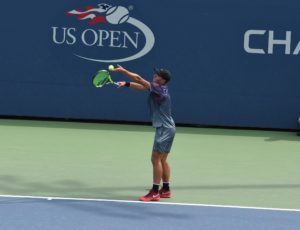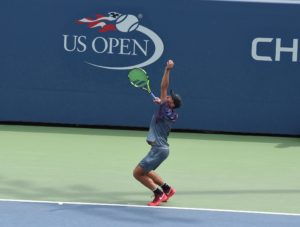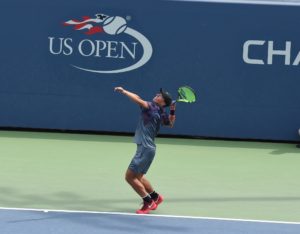Ernesto Escobedo – Suboptimal service & forehand combination

Ernesto Escobedo (*1996 / USA) belongs to the group of the young male American tennis players. Like it’s the case with many of them, certain missing details around the technique-regulatory complex (= fully or partly missing TENNIS 3.0 CODE as well as improper use of the 3 Step Tennis Stroke Regulation) of his strokes quite significantly limit the capacity of his game.
In today’s tennis, which is dominated by shorter points (the majority of the points is being decided in the first 4 strokes), penetrating well-placed service and dominant 3rd stroke (answer to opponent’s return) are essential for any really significant success in the game. For both the service and the 3rd stroke, the ability to fully unload the stored body energy against the ball/target plays the deciding role. In the case of the service, the full targeted pronation (incorporating the form of the long-axis pronation) is one of the main aspects leading to the optimal body energy unloading. In the case of the 3rd stroke (mostly forehand or backhand), a good spacing is essential for the possibility to let the elbow and the racket fly (to throw them) far away from the body (core) against the target, which can, if done right, lead to the optimal body energy unloading in these strokes.
The video and photos of Ernesto shown below document quite well two of the main issues, which often limited his service & 3rd stroke/forehand combination during his lost 1st round match against Radu Albot (*89 / MDA) at the 2017 US.Open. The often suboptimal pronation partly limited the penetration his 1st service, which was because of Ernesto’s significant power potential still strong enough to give him (due to just an average return from his opponent) the possibility to play the deciding 3rd stroke with his forehand. But in both cases shown here, Ernesto didn’t create an optimal space to be able to “throw his elbow and racket” away from the body against the target and the result was in both cases just a mediocre forehand not putting the opponent under significant pressure. The main reason behind the suboptimal spacing might then not be primarily in the poor footwork capacity, but much rather in the wrong programming (wrong mental image) of the desired stroke action and its regulation into the direction where both the hitting and the regulatory activity of the arm/elbow might play too big of a role. The players with years of training guided by this (suboptimal) idea (mental image) of the desired dominant arm activity aka “racket head speed is everything” (also American players like Ryan Harrison, Donald Young, Michael Mmoh and quite few others) tend to have a reduced focus on the optimal 1st regulation (= proper spacing) and have because of the “overload” during the 2nd regulation (the mentioned arm/elbow activity) only a limited capacity for the 3rd regulation, which is the proprioceptive (invisible) regulation of the stroke…
In a summary, the few very top players using in most of their strokes the “3 Step Tennis Stroke Regulation” (mostly subconsciously based on proper reference points aka TENNIS 3.0 CODE guiding their strokes) tend to focus at better spacing (=1st regulation), which gives them the possibility to “throw” the elbow and racket far away from the body against the target (=2nd regulation) and this total body approach with energy unloading gives them the opportunity to use also the proprioceptive regulation through their entire bodies and mainly in their hitting arms (=3rd regulation). This “3 Step Tennis Stroke Regulation” approach makes a very efficient modern game with an optimal tradeoff between the power and control possible. In contrary, the players focusing on the racket head speed connected to the elbow bending, which leaves the elbow close to the body, are losing in both power and control areas. This deficiency is connected mainly with the wrong mental images of the ideal strokes going often back to ill-conceived methodologies.
In this serving point, Ernesto’s pronation was not that ideal that his service would result in an ace or would make the return of the opponent impossible. But it was still good enough that Ernesto had the chance to run around to ideally play a very dominant (eventually winning) 3rd stroke with his forehand. His limited spacing and focus at hitting arm activity with an early elbow bending then lead to just a mediocre stroke coming into the comfort zone of his opponent. As the strokes hit with the early elbow bending tend to be less precise, significantly bigger margin is needed to be calculated while using them. In contrary, players focusing on the elbow extension against the target (like Roger Federer, Rafael Nadal, Novak Djokovic) can calculate with much smaller margin and this way they can immediately go for the winning or at least the opponent increasingly challenging 3rd stroke.

Ernesto Escobedo (*96 / USA) – 1st service in a match – 2 of 11 – toss 1 / backswing 1 – both arms are starting almost at the same time – 2017 US.Open – New York

Ernesto Escobedo (*96 / USA) – 1st service in a match – 4 of 11 – loading 1 – 2017 US.Open – New York

Ernesto Escobedo (*96 / USA) – 1st service in a match – 5 of 11 – loading 2 – 2017 US.Open – New York

Ernesto Escobedo (*96 / USA) – 1st service in a match – 6 of 11 – loading 3 – the backswing is very short, the right shoulder doesn’t rotate back much – this mostly limits the margins of the service, left arm pointing at the tossed ball stabilizes the body position – 2017 US.Open – New York

Ernesto Escobedo (*96 / USA) – 1st service in a match – 7 of 11 – push-off 1 – racket starts to travel into the cocking position – 2017 US.Open – New York

Ernesto Escobedo (*96 / USA) – 1st service in a match – 8 of 11 – the culmination of the push-off with both feet off the ground is connected to the release of the racket for an explosive upwards motion from the cocking position up to the ball – 2017 US.Open – New York

Ernesto Escobedo (*96 / USA) – 1st service in a match – 9 of 11 – follow through 1 – the pronation was not fully completed, hitting arm falls down rather too early – this tends to limit the precision and the power/penetration capacity of the service – 2017 US.Open – New York

Ernesto Escobedo (*96 / USA) – 1st service in a match – 10 of 11 – follow through 2 = relaxation showing the signs that the energy unloading against the target was rather not optimal – 2017 US.Open – New York

Ernesto Escobedo (*96 / USA) – 1st service in a match – 11 of 11 – end with rather slower recovery / later preparation for the 3rd stroke – 2017 US.Open – New York

Ernesto Escobedo (*96 / USA) – Forehand as the 3rd stroke in a match (following the service shown above) – 1 of 3 – short after the impact – limited spacing didn’t make the unloading of the body energy into the stroke possible – 2017 US.Open – New York

Ernesto Escobedo (*96 / USA) – Forehand as the 3rd stroke in a match – 2 of 3 – follow through 2 = relaxation – shows how limited the body action in the stroke was, it was dominated by the arm action – 2017 US.Open – New York

Ernesto Escobedo (*96 / USA) – Forehand as the 3rd stroke in a match – 3 of 3 – recovery – out of balance and without an optimal ready position for the following stroke – 2017 US.Open – New York
This article covers certain aspects of the Ernesto Escobedo’s service and forehand as well as these strokes in general only. Further photos and more details about his service/forehand and about the strokes of other players are available upon request at drmgb11(at)gmail.com. Some significant details of this kind necessary for top tennis performance are being discussed also in the seminar “TENNIS 3.0 – Future of the Game”, which is available worldwide upon request – www.tennis30.cz
Video/Photos (August 2017) & text (October 2017) copyright by Dr. Martin G. Baroch. Any further publication of either video/photos and/or texts with the written permission of the author/copyright owner only!!





